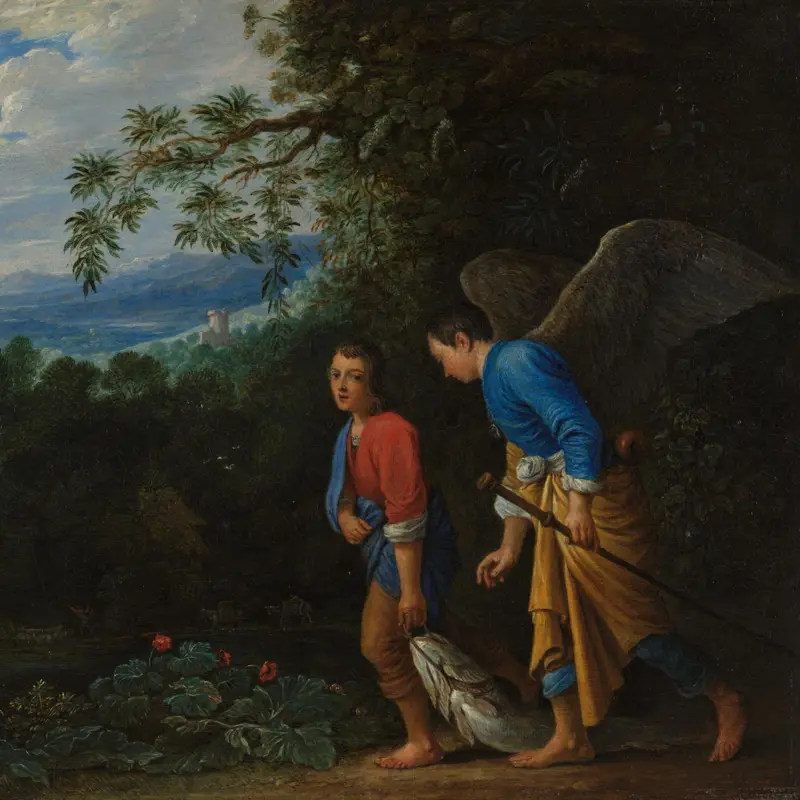Adam Elsheimer, 'The Baptism of Christ', about 1599
About the work
Overview
Christ is shown bending down in the River Jordan as Saint John baptises him, pouring water over his head. An angel and two cherubs carry a red cloth to wrap around Christ after his baptism. The sky has opened up to reveal the intense light of heaven where the bearded figure of God the Father is surrounded by cherubs. According to the Gospel, God declared: ‘This is my beloved son in whom I am well pleased’ (Matthew 3: 17). The Holy Ghost, represented as a dove, descends from heaven through a circle of naked winged cherubs.
This work is thought to have been painted during the artist’s stay in Venice from 1598 to 1600. The vibrant colours, the dramatic use of light as a way of reinforcing the narrative and the dynamic movement of the figures creating a zig-zag type of composition reflect the works of his Venetian contemporaries, particularly Tintoretto and Veronese.
Key facts
Details
- Full title
- The Baptism of Christ
- Artist
- Adam Elsheimer
- Artist dates
- 1578 - 1610
- Date made
- about 1599
- Medium and support
- oil on copper
- Dimensions
- 28.1 × 21 cm
- Acquisition credit
- Presented by Henry Wagner, 1924
- Inventory number
- NG3904
- Location
- Room 26
- Collection
- Main Collection
- Frame
- 18th-century French Frame
Provenance
A painting with an arched top by ‘Adamo’ of Saint John the Baptist baptising Christ was recorded in inventories of the family of the Flemish painter Karel Oldrago or Oldrado, who died in Rome in 1619. The references occur in the inventories of 1619, 1620 and 1635: on 11 May 1619 (‘un San Giovanni battista in rame dentro in una scattola ovato all meta di mano di Adamo’) and on 29 May of the same year (‘un San Giovanni battista in rame dentro una scatola ovato alla metà di mano d’Adamo’); in 1620 (‘Un San’Giovanni battista che battezza Il Signore senza cornice alto un palmo, e poco più ... di mano d’Adamo pittore’); and in 1635 (‘un’altro [quatro] di San Giovanni che battezza Nostro Signore’). By the latter date the paintings had come into the possession of Oldrado’s younger sons Fabio and Egidio (born 1612) and their cousin and guardian Stefano Landi, and the family paintings divided between them. In November 1635 the painting was selected from the collection by Fabio Oldrado; before 1 November 1637 he had left Rome to become a musician at the Florentine court in the service of Gian Carlo de’ Medici (1611–1663), and he is last recorded in January 1640.
NG 3904 is possibly the painting of the baptism with four aerial angels in an ebony frame described as by ‘Andrea Hamer’ in 1653 when in the collection of Cardinal Jules Mazarin (1602–1661) in Paris. When NG 3904 was acquired by the National Gallery in 1924 it was in a régence-style carved and gilded walnut frame, probably French and dating from the early eighteenth century. On the back of the frame is a seal, with the coat of arms of an ecclesiastic, a bishop’s mitre visible to the left, and a crown above. The style of this frame (as well as perhaps the existence of a drawing after the painting today in Paris) suggests that NG 3904 was in a French collection around 1705–25. It is likely to be the painting of the Baptism by Elsheimer in a gilded frame which was sold in Paris in May 1733 in the Monsieur de la Chataigneraye sale. Charles Clinet de la Chataigneraye (died 1732) was argentier to the children of King Louis XIV. It may well be the painting in the sale of the marquis de Lassay and others on 22 May 1775; the description and size align closely with NG 3904. This may again be identical to the painting of a Baptism said to be by Elsheimer sold in London in 1791 from the collection of Charles-Louis de Beauchamp, comte de Merle (1723–1793), diplomat and collector.
If the painting remained in France until 1775 and after it cannot be, as previously suggested, the picture in the ‘J. Schuckborough deceased and others’ sale at Christie’s, London, 1 March 1771, lot 59, unsold, or the picture in an anonymous sale at Christie’s, London, 27 March 1779, lot 70 (second day), bought Shriber. It is similarly unclear whether NG 3904 can be the painting in the Sir Joshua Reynolds sale at Christie’s, 14 March 1795, lot 27 (fourth day), bought Dermer; this might be the painting in the sale at Christie’s, 25 April 1812, lot 132, bought Bowden (bought in).
NG 3904 was in the George Smith sale at Christie’s, 27 May 1882, lot 16, where it was bought by Orlando Henry Wagner (1867–1956), who presented it to the National Gallery in 1924.
Additional information
Text extracted from the ‘Provenance’ section of the catalogue entry in Susan Foister, ‘National Gallery Catalogues: The German Paintings before 1800’, London 2024; for further information, see the full catalogue entry.
Bibliography
-
1959Levey, Michael, National Gallery Catalogues: The German Schools, London 1959
-
2001
C. Baker and T. Henry, The National Gallery: Complete Illustrated Catalogue, London 2001
-
2024S. Foister, National Gallery Catalogues: The German Paintings before 1800, 2 vols, London 2024
About this record
If you know more about this work or have spotted an error, please contact us. Please note that exhibition histories are listed from 2009 onwards. Bibliographies may not be complete; more comprehensive information is available in the National Gallery Library.



